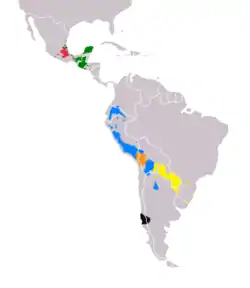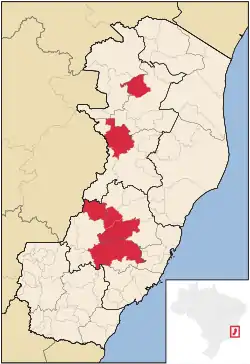Languages of South America
The languages of South America can be divided into three broad groups:
- the languages of the (in most cases, former) colonial powers
- many indigenous languages, some of which are co-official alongside the colonial languages
- and various pockets of other languages spoken by immigrant populations
.png.webp)
Main languages

| Quechua | Guarani | Aymara |
| Nahuatl | Mayan languages | Mapudungun |
Spanish is the primary language of South America and its most spoken language, but most people in Brazil speak Portuguese[1] by a small margin.[2] Spanish, with slightly more speakers than Portuguese, is the most spoken language on the continent.
Other official and majority languages in specific countries are:
- Dutch in Suriname
- English in Guyana, the Falkland Islands (Spanish: Islas Malvinas) and South Georgia and the South Sandwich Islands
- French in French Guiana, an overseas department of France.
Indigenous languages

Indigenous languages of South America include, among several others, the Quechua languages in Bolivia, Peru, Ecuador and to a lesser extent in Argentina, Chile and Colombia; Guaraní in Paraguay and to a much lesser extent in Argentina and Bolivia; Aymara in Bolivia, Peru and to a lesser extent in Chile; Wayuu in northern Colombia and northwest Venezuela; and Mapudungun in small pockets of southern Chile and Argentina.
In Bolivia, Quechua, Aymara, and Tupi Guarani are co-official alongside Spanish. In Paraguay, Guarani shares joint official status with Spanish. In Colombia, the languages of the country's ethnic groups are constitutionally recognized as official languages in their territories; more than 60 such aboriginal languages exist today. In Ecuador, Spanish, Northern Quechua and Shuar are official for intercultural relations. In Peru, Quechua, Aymara, and other indigenous languages are co-official in the areas where they are predominant. There are many other languages once spoken in South America that are extinct today (such as the extinct languages of the Marañón River basin).
In Brazil, there are around 135 indigenous languages confirmed. The regions with the most speakers are northern and southern Brazil, where there is a larger concentration of native people. Indigenous populations have been trying to keep their traditions of their homeland, with the help of Funai, the agency responsible for the protection of the native people.
| Language | Speakers | Countries |
|---|---|---|
| Quechua | 8,900,000[3] | Peru, Bolivia, Ecuador, Argentina, Chile, Colombia |
| Guarani | 4,900,000[4] | Paraguay, Bolivia, Argentina |
| Aymara | 2,800,000[5] | Bolivia, Peru |
Classification
- Macro-Chibchan
- Chibchan
- Chibcha-Duit, Tunebo, Arhuaco, Cuna-Cueva, Guaymi-Dorasque, Talamanca, Rama-Guatuso
- Misumalpan, Paya, Xinca, Lenca
- Shiriana
- Paezan
- Choco, Cuaiquer, Andaki, Paez-Coconuco, Colorado-Cayapa, Warrau, Mura-Matanawi, Jirajira, Yunca, Atacameno, Itonama
- Chibchan
- Andean-Equatorial
- Andean
- Jibaro-Kandoshi, Esmeralda, Cofan, Yaruro
- Macro-Tucanoan
- Equatorial
- Ge-Pano-Carib
Source:[6]
Other languages


Italian is spoken by communities in Argentina, Brazil, Chile, Colombia, Uruguay, Peru, and Venezuela.
German is used by some in Brazil, Argentina, Chile, Colombia, Venezuela, Peru, Bolivia, and Paraguay.
Speakers of Arabic (chiefly of Lebanese, Syrian or Palestinian descent), are commonly found in parts of in Brazil, Colombia, Guyana, Suriname, Argentina, Paraguay, Chile (largest Palestinian colony outside the Middle East) and Venezuela.
Welsh is spoken and written in the historic towns of Trelew and Rawson in the Argentine Patagonia.
There are small Croatian, Greek, Polish, Ukrainian and Russian-speaking communities in Brazil, Chile, and Argentina.
There are also many Romani-speakers, originating in Eastern Europe, throughout South America particularly in Colombia, Chile, Brazil, and Argentina.
There are Eastern European Romanian speakers, especially in Argentina, Brazil, Chile and Colombia, where Romanian populations live.
There are also small clusters of Japanese-speakers in Brazil, Peru, Bolivia (including Okinawans from the island of Okinawa), Colombia, Paraguay, and Ecuador. Brazil currently holds the largest Japanese community outside Japan [23]
Caribbean Hindustani is spoken by the Indo-Guyanese and the Indo-Surinamese.[24] In Suriname, the language is known as Sarnami Hindoestani and is still widely spoken, however in Guyana where it is known as Aili Gaili,[25] the language is nearly extinct as a spoken language with only words and phrases still remaining. [26]
Javanese is spoken by the Javanese Surinamese who form about 14% of the country's population[27]
Sranan Tongo, an English-based creole serves as one of the lingua francas of Suriname alongside Dutch.[28]
The Rapa Nui Language is a Polynesian origin found in Easter Island, Chile. Maori is also found in Easter Island.
Most South American countries mandate the regular study of one or more of English, French, German or Italian. These countries often have advanced cultural language institutes for those respective languages centered in their major cities.
In Brazil, Italian and German dialects, specifically Talian, East Pomeranian and Riograndenser Hunsrückisch, have co-official status alongside Portuguese in about a dozen cities, and are mandatory subjects in schools in other municipalities. Brazil's largest city São Paulo has large numbers of German, Italian, Japanese and Levantine Arabic speakers. The states of Santa Catarina[29][30][31] and Rio Grande do Sul have Talian officially approved as a heritage language in these states,[32] and Espírito Santo has the East Pomeranian dialect,[33] along with the German language as cultural heritage.[33][34][35][36][37] [38]
See also
References
- Babbel.com; GmbH, Lesson Nine. "How Many Brazilian People Speak Portuguese, And Where Is what is the timeIt Spoken? | Babbel Magazine". The Babbel Magazine. Retrieved 2019-04-01.
- Lopez, Michel. "What are the 5 official languages of South America?". e2f. Retrieved 2019-04-01.
- Mikael Parkvall, "Världens 100 största språk 2007" (The World's 100 Largest Languages in 2007), in Nationalencyklopedin
- Guarani at Ethnologue (18th ed., 2015)
- Central Aymara at Ethnologue (18th ed., 2015), Southern Aymara at Ethnologue (18th ed., 2015)
- Greenberg, Joseph H. "The general classification of Central and South American languages", in: Men and cultures; selected papers of the 5th international congress of anthropological and ethnologicalsciences, Philadelphia, September 1956 PP. 791-4
- "Câmara Bento – Projeto do Executivo é aprovado e Talian se torna a língua co-oficial – Jornal Cidades da Serra". 24 September 2016. Archived from the original on 24 September 2016.
- "Lei confirma o Talian como segunda língua oficial de Caxias do Sul". 30 March 2019. Archived from the original on 30 March 2019.
- "Leouve - Talian é língua cooficial de Flores da Cunha". 15 June 2016. Archived from the original on 15 June 2016.
- Lei Nº 1310 de 16 de outubro de 2015 - Dispõe sobre a cooficialização da língua do "talian", à língua portuguesa, no município de Nova Roma do Sul"
- O Talian agora é a língua co-oficial de Nova Roma do Sul, município de Nova Roma do Sul
- "Município de Serafina Corrêa Vereadores aprovam o talian como língua co-oficial do município". 30 March 2019. Archived from the original on 30 March 2019.
- Espírito Santo investe na preservação da língua pomerana, in "Registros Escritos", fifth paragraph.
- "A escolarização entre descendentes pomeranos em Domingos Martins" (PDF) (in Portuguese). Archived from the original (PDF) on 21 December 2012. Retrieved 24 August 2011.
- "A co-oficialização da língua pomerana (third paragraph)" (PDF) (in Portuguese). Archived from the original (PDF) on 21 December 2012. Retrieved 24 August 2011.
- Município de Itarana participa de ações do Inventário da Língua Pomerana, Prefeitura Municipal de Itarana
- «Lei Municipal nº 1.195/2016 de Itarana/ES». itarana.es.gov.br
- "Pomerano!?" (in Portuguese). Retrieved 24 August 2011.
- "No Brasil, pomeranos buscam uma cultura que se perde" (in Portuguese). Archived from the original on 28 March 2012. Retrieved 24 August 2011.
- "Lei dispõe sobre a cooficialização da língua pomerana no município de Santa maria de Jetibá, Estado do Espírito Santo" (in Portuguese). Archived from the original on 2 April 2012. Retrieved 24 August 2011.
- Cooficialização de línguas no Brasil: características, desdobramentos e desafios, third page.
- "Vila Pavão, Uma Pomerânia no norte do Espirito Santo" (in Portuguese). Retrieved 24 August 2011.
- "Japan, Brazil mark a century of settlement, family ties | The Japan Times Online". 2008-01-15.
- Frawley, William (2003). International Encyclopedia of Linguistics: 4-Volume Set. Oxford University Press, USA. pp. 481–482. ISBN 978-0-19-513977-8.CS1 maint: date and year (link)
- "Language". Caribbean Hindustani. Retrieved 2021-01-04.
- "The Linguistic Legacy of Indian-Guyanese". Stabroek News. 2014-04-21. Retrieved 2021-01-04.
- "Suriname - The World Factbook". www.cia.gov. Retrieved 2021-01-04.
- "Redirected". Ethnologue. 2019-11-19. Retrieved 2021-01-04.
- "LEI Nº 14.951" (in Portuguese). Retrieved 21 August 2011.
- "Rotary apresenta ações na Câmara. FEIBEMO divulga cultura italiana" (in Portuguese). Retrieved 21 August 2011.
- "Fóruns sobre o Talian - Eventos comemoram os 134 anos da imigração italiana" (in Portuguese). Archived from the original on 30 July 2012. Retrieved 21 August 2011.
- "Aprovado projeto que declara o Talian como patrimônio do RS]" (in Portuguese). Archived from the original on 27 January 2012. Retrieved 21 August 2011.
- "O povo pomerano no ES" (in Portuguese). Archived from the original on 21 December 2012. Retrieved 24 August 2011.
- "Plenário aprova em segundo turno a PEC do patrimônio" (in Portuguese). Archived from the original on 27 January 2012. Retrieved 21 August 2011.
- "Emenda Constitucional na Íntegra" (PDF) (in Portuguese). Retrieved 21 August 2011.
- "ALEES - PEC que trata do patrimônio cultural retorna ao Plenário" (in Portuguese). Archived from the original on 14 December 2013. Retrieved 21 August 2011.
- "TITUS Didactica: German Dialects (map)". titus.uni-frankfurt.de.
- "Pommern in Brasilien - LernCafe – Online-Journal zur allgemeinen Weiterbildung". www.lerncafe.de.
External links
- Nicolai, Renato (2006). "Vocabulários e dicionários de línguas indígenas brasileiras".
- Petrucci, Victor A. (2007). "Línguas Indígenas".
- South American Indigenous Language Structures
- SAPhon – South American Phonological Inventories
- Sound comparisons for various South American languages
- Diachronic Atlas of Comparative Linguistics (DiACL)